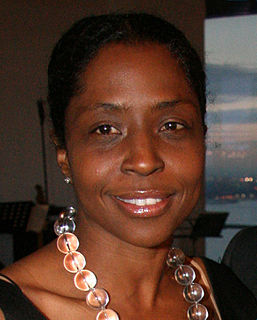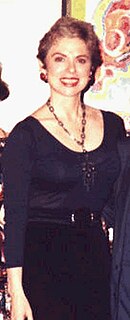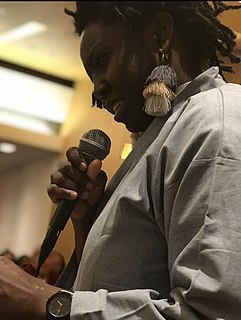Related Research Articles

Lorraine O'Grady is an American artist and critic. She works in conceptual art and performance art that integrates photo and video installation. Her work explores the cultural construction of identity - particularly that of black female subjectivity - as shaped by the experience of diaspora and hybridity.

Graciela Iturbide is a Mexican photographer. Her work has been exhibited internationally, and is included in many major museum collections such as the San Francisco Museum of Modern Art and The J. Paul Getty Museum.

Lola Álvarez Bravo was the first Mexican female photographer and a key figure in the post-revolution Mexican renaissance. Known for her high level of skill in composition, her works were seen by her peers as fine art. She was recognized in 1964 with the Premio José Clemente Orozco, by the State of Jalisco, for her contributions to photography and her efforts to preserve the culture of Mexico. Her works are included in the permanent collections of international museums, including the Museum of Modern Art in New York City.
Wangechi Mutu is a Kenyan-American visual artist known primarily for her painting, sculpture, film, and performance work. Born in Kenya, she has lived and established her career in New York for more than twenty years. Mutu's work has directed the female body as subject through collage painting, immersive installation, and live and video performance all the while exploring questions of self-image, gender constructs, cultural trauma, and environmental destruction as well as notions of beauty and power.

Kelly Richardson is a Canadian artist working with digital technologies to create hyper-real landscapes.
Kathy Vargas is an American artist who creates collages and photographs. She often devotes several works to a particular theme and creates her art in series.

Lorna Simpson is an American photographer and multimedia artist. She came to prominence in the 1980s and 1990s with artworks such as Guarded Conditions and Square Deal. Simpson in most well known for her work in conceptual photography. Her works have been included in numerous exhibitions both nationally and internationally. She is best known for her photo-text installations, photo-collages, and films. Her early work raised questions about the nature of representation, identity, gender, race and history. Simpson continues to explore these themes in relation to memory and history in various media including photography, film, video, painting, drawing, audio, and sculpture.

Regina José Galindo is a Guatemalan performance artist who specializes in body art. She was born in Guatemala City.
Linda Connor is an American photographer living in San Francisco, California. She is known for her landscape photography.
Marta María Pérez Bravo is a Cuban artist who is best known for her black-and-white self-portraiture, in which she often uses her own body as the central subject-object to express her own belief in - and practice of - Afro-Cuban religions, particularly Santeria and Palo Monte. Much of her art is informed by this practice, and engages with the themes of ritual, motherhood and femininity, expressed through the highly stylized posing of her body, which is placed in relation to personally and ritually significant objects in her self-portraits.
Martha Wilson is an American feminist performance artist and the founding director of Franklin Furnace Archive art organization. Over the past four decades she has developed and "created innovative photographic and video works that explore her female subjectivity through role-playing, costume transformation, and 'invasions' of other peoples personas". She is a recipient of two National Endowment for the Arts fellowships, a New York Foundation for the Arts fellowship, and an Obie Award and a Bessie Award for commitment to artists’ freedom of expression. She is represented by P•P•O•W gallery in New York City.
Harmony Hammond is an American artist, activist, curator, and writer. She was a prominent figure in the founding of the feminist art movement in 1970's New York.
Laura Aguilar was an American photographer. She was born with auditory dyslexia and attributes her start in photography to her brother who showed her how to develop in dark rooms. She was mostly self-taught although she took some photography courses at East Los Angeles College where her second solo exhibition Laura Aguilar: Show and Tell was held. She is well known for her portraits, mostly of herself and also focused upon people in marginalized communities including LGBT and Latino subjects and obese people.

Joyce J. Scott is an African-American artist, sculptor, quilter, performance artist, installation artist, print-maker, lecturer and educator. Named a MacArthur Fellow in 2016, and a Smithsonian Visionary Artist in 2019, Scott is best known for her figurative sculptures and jewelry using free form, off-loom beadweaving techniques, similar to a peyote stitch. Each piece is often constructed using thousands of glass seed beads or pony beads, and sometimes other found objects or materials such as glass, quilting and leather. In 2018, she was hailed for working in new medium — a mixture of soil, clay, straw, and cement — for a sculpture meant to disintegrate and return to the earth. Scott is influenced by a variety of diverse cultures, including Native American and African traditions, Mexican, Czech, and Russian beadwork, illustration and comic books, and pop culture.

Nancy Glenn-Nieto is an American-Mexican actress, model, and fine art painter. She is perhaps best known as a model and an actress in Mexico City; however, her art work has become highly collectable. She is the widow of Mexican Oaxacan painter Rodolfo Nieto.
Susan Harbage Page is an American photographer and visual artist who explores issues of race, gender, and immigration through photography, site-specific Installation Art, painting, and drawing. She is the recipient of numerous awards and fellowships and is Assistant Professor in the Department of Women's and Gender Studies at the University of North Carolina at Chapel Hill.
Rosa Amelia Rivera is an American television personality and businesswoman. Rivera is the current chief executive officer of Jenni Rivera Enterprises. Rivera first gained media attention through her sister Jenni Rivera's death but she received wider notice after she began to star in Spanish-language reality shows and taking over her sister's enterprise. In late 2014, she and her family began to appear in the reality television series Rica, Famosa, Latina.

Autumn Knight is an interdisciplinary artist working with performance, installation, and text from Houston, Texas who lives and works in New York City. Knight attended the High School for Performing and Visual Arts in Houston, TX and went on to achieve an M.A. in Drama Therapy, from New York University and a B.A. in Theatre Arts/Speech Communications from Dillard University. Knight holds certificates in Arts Management & Marketing from Birkbeck College in London, U.K. and in Speech & Drama from Central School of London.
Alicia Creus is an Argentine artist who currently resides in the United States. She is known for using unusual media such as fabric and lace to create her pieces.

Daniela Edburg is a Mexican American visual artist who creates photo-based works.
References
- 1 2 3 4 "Daniela Rossell". Tate Museum. Retrieved 2020-04-23.
- 1 2 3 4 5 Thompson, Ginger (September 25, 2002). "The Rich, Famous and Aghast: A Peep Show". The New York Times. Retrieved 7 March 2015.CS1 maint: discouraged parameter (link)
- 1 2 "5 Fast Facts: Daniela Rossell". Museum Hue. Retrieved 2020-04-23.
- 1 2 Campion, Chris (2001-12-31). "Tijuana brass". The Telegraph. ISSN 0307-1235 . Retrieved 2020-04-23.
- 1 2 3 "Artist Profiles: Daniela Rosell, National Museum of Women in the Arts".
- ↑ "Photography: Between Screen and Performance, Daniela Rossell (Artist, Mexico City) : Department of Spanish and Portuguese". University of California at Berkeley. Retrieved 2020-04-23.
- 1 2 3 "Studio Lecture Series: Daniela Rossell | Department of Art & Art History". art.stanford.edu. Retrieved 2020-04-23.
- ↑ "5 Fast Facts: Daniela Rossell, Museum Hue".
- ↑ "Artist Bio, Greene Naftali Gallery".
- ↑ "San Francisco Museum of Modern Art" . Retrieved 1 February 2014.CS1 maint: discouraged parameter (link)
- ↑ "Nico Israel on Daniela Rossell". www.artforum.com. Retrieved 2020-04-23.
- 1 2 Coppelman, Alyssa (2012-12-11). "The Poor Little Rich Girls of Mexico". Slate Magazine. Retrieved 2020-04-23.
- 1 2 "Houston Institute E-culture Newsletter". www.houstonculture.org. Retrieved 2020-04-23.
- 1 2 3 "Strozzina". www.strozzina.org. Retrieved 2020-04-23.
- 1 2 3 "Daniela Rossell: Ricas y Famosas at Blaffer Gallery". artdaily.cc. Retrieved 2020-04-23.
- ↑ "Ricas y Famosas » Artpace". www.artpace.org. Retrieved 2020-04-23.
- ↑ "Latin American Art" . Retrieved 1 February 2014.CS1 maint: discouraged parameter (link)
- 1 2 "Daniela Rossell | MoMA". The Museum of Modern Art. Retrieved 2020-04-23.
- ↑ "Ricas y Famosas » Artpace". www.artpace.org. Retrieved 2020-04-23.
- ↑ "Made in Mexico | Hammer Museum". hammer.ucla.edu. Retrieved 2020-04-23.
- ↑ "Photographing the female body". BBC News. 2017-01-25. Retrieved 2020-04-23.
- ↑ "Terrains of the Body: Photography from the National Museum of Women in the Arts". Whitechapel Gallery. Retrieved 2020-04-24.
- 1 2 "Weatherspoon Art Museum - Inge with Dog Pound, from the series Ricas y Famosas (Rich and Famous)". weatherspoonartmuseum.org. Retrieved 2020-04-24.
- ↑ "Exhibitions". New Museum Digital Archive. Retrieved 2020-04-24.
- ↑ "Untitled (Paulina with Lion) (Getty Museum)". The J. Paul Getty in Los Angeles. Retrieved 2020-04-23.
- ↑ "Daniela Rossell, Untitled (Ricas y famosas) (rooftop), 1999". MCA. Retrieved 2020-04-23.
- ↑ "Itati Crying in her Dining Room". Saint Louis Art Museum. Retrieved 2020-04-23.
- ↑ Querétaro, Donna Oliveros|Diario de. "Llega a Querétaro colección de la Fundación Jumex". Diario de Querétaro (in Spanish). Retrieved 2020-04-24.